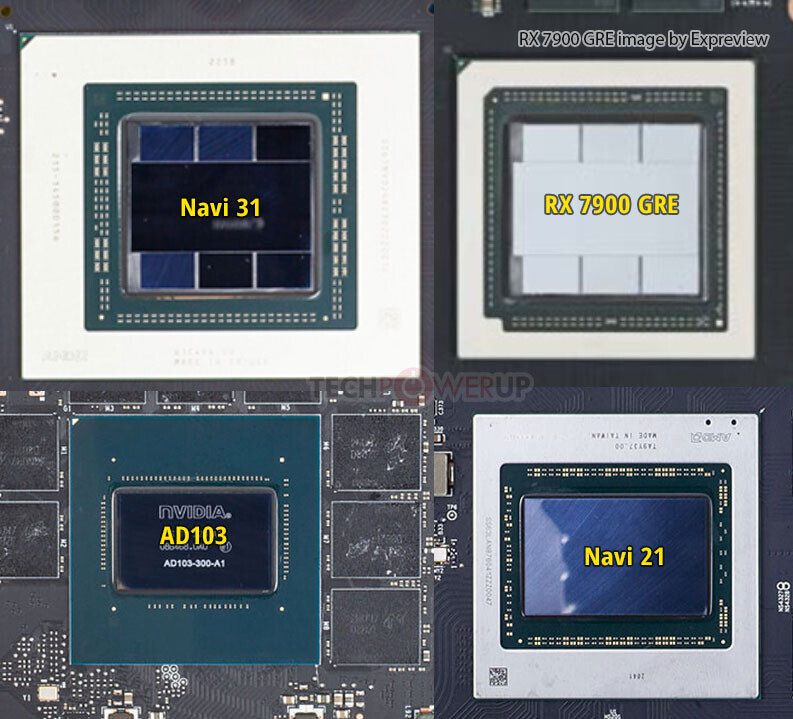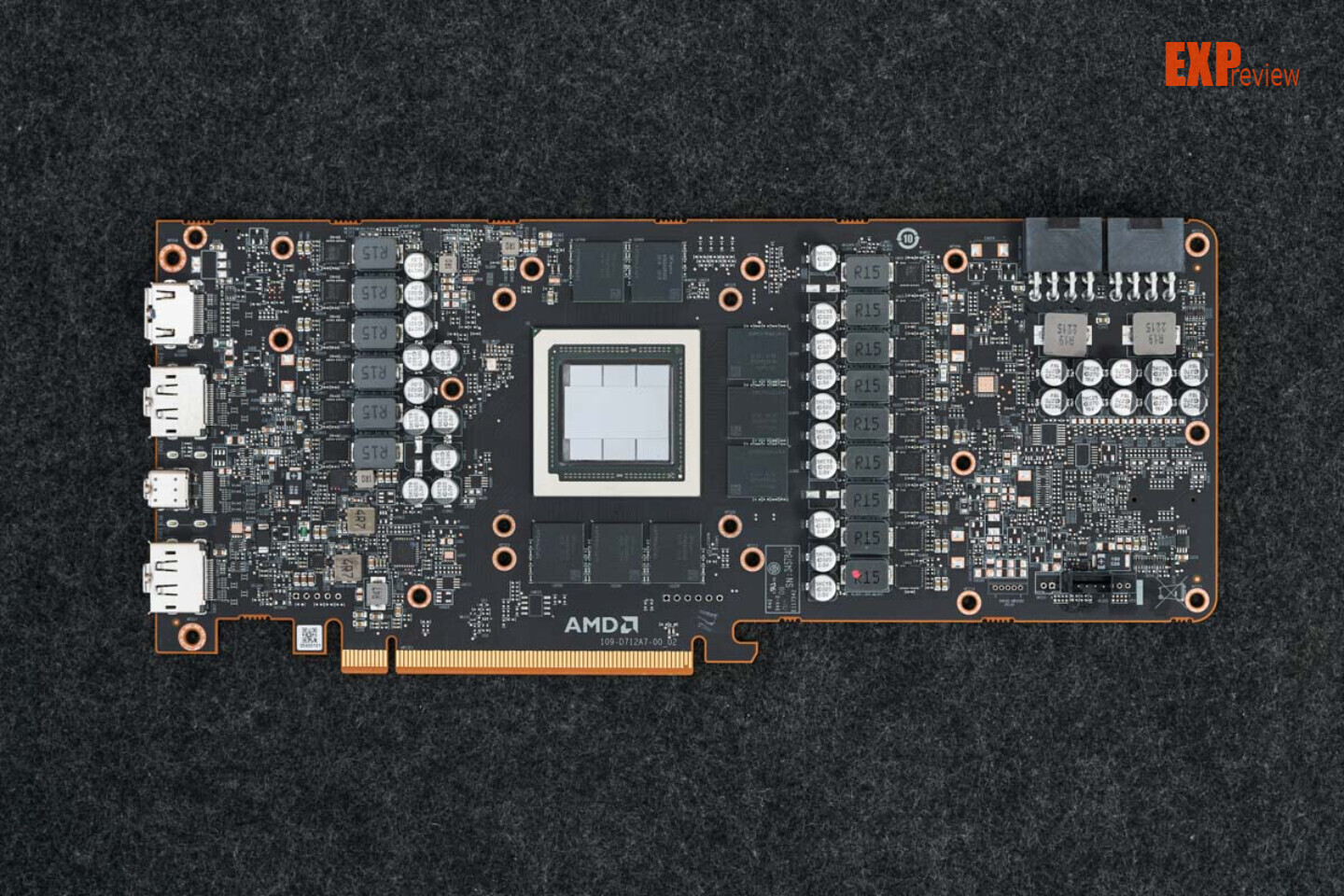AMD Shrank Navi 31 in RX 7900 GRE, Smaller Than 7900 XT and XTX
Where did the extra 4 billion transistors go?

TechPowerUp has discovered that AMD's new RX 7900 GRE features some physically altered properties compared to its bigger RX 7900 series brothers. Even though all three GPUs share the exact same die model, the Navi 31 package found on the 7900 GRE is physically smaller than the one found on the 7900 XT and XTX.
According to an image TechPowerUp (via Expreview) made comparing the 7900 GRE's new package size to Navi 21, AD103, and original Navi 31, the RX 7900 GRE's die packaging has been noticeably altered. The package's outer silver border has been thinned down considerably and reshaped so that the package's physical dimensions look like a square. As a result, the GRE's Navi 31 is closer in size to Navi 21 and is smaller than Nvidia's AD103 that powers the RTX 4080. (The physical size of the GPU die and MCDs remains the same; the only thing that became smaller is the GPU packaging.)


Additionally, the PCB of the RX 7900 GRE is also very different and looks tailor-made specifically for AMD's (currently) China-exclusive RDNA 3 GPU. The biggest differentiator is the number of memory packages installed on the PCB: just eight pads, compared to twelve pads on the RX 7900 XT and XTX.
We suspect that AMD has physically removed the additional piping that was put in place to run the RX 7900 XTX's 384-bit wide memory bus, which would also explain the redesigned PCB. The RX 7900 GRE features a 256-bit wide memory bus, which is significantly narrower compared to the RX 7900 XTX. As a result, removing two MCDs worth of piping is probably how AMD shrunk Navi 31 so much.
What's particularly curious is that AMD's RX 7900 GRE specifications page lists 54 billion transistors for the new chip. The RX 7900 XTX and RX 7900 XT page meanwhile list 58 billion transistors. It could just be a typo, but clearly there's more going on behind the scenes than might otherwise be immediately apparent.
Physically altering a GPU package like AMD has done with the RX 7900 GRE isn't too difficult, but altering the die would be very unusual — that takes a lot of money and time to pull off. We cannot be sure of AMD's exact changes or the reasons for the changes. Regardless, it would be very odd for AMD to go through all this hassle for one SKU that's limited to China.
We expect this revised Navi 31 will show up in some other GPU models down the road, possibly in the RX 7800 series and/or mobile GPU equivalents. Meanwhile, Navi 32 GPUs have not yet shown up.
Get Tom's Hardware's best news and in-depth reviews, straight to your inbox.

Aaron Klotz is a contributing writer for Tom’s Hardware, covering news related to computer hardware such as CPUs, and graphics cards.
-
AgentBirdnest Title: "AMD Shrank The Navi 31 Die In RX 7900 GRE"Reply
Article: "The physical size of the GPU die and MCDs remains the same, the only thing that became smaller is the GPU packaging."
The title is a lie. I'm annoyed. -
TechyInAZ Oops I forgot to delete the word die, when I was editing. Thanks for pointing that out!Reply -
qwertymac93 Reply
The sub-title blurb has the same problem...TechyInAZ said:Oops I forgot to delete the word die, when I was editing. Thanks for pointing that out! -
Alvar "Miles" Udell ReplyBut, altering a GPU die like AMD has done with the RX 7900 GRE is very unusual, and takes a lot of money and time to pull off. We cannot be sure of AMD's exact reasons for making these expensive changes to Navi 31, but it would be very illogical for AMD to go through all this hassle for one SKU. So we should see this same die in other GPU models down the road, possibly in the RX 7800 series and mobile GPU equivalents.
AMD using a different GPU for a different model? Who would have thought...Oh wait, everyone... -
usertests It matches a MLID leak in June, Navi 31 made to fit inside the Navi 32 package.Reply
https://wccftech.com/amd-navi-32-rdna-3-gpu-package-pictured-navi-31-gpu-die-six-mcd-compact-form-factor/https://cdn.wccftech.com/wp-content/uploads/2023/06/AMD-Radeon-RX-7800-XT-Navi-32-GPU-Package-With-Navi-31-GPU-Die-_1.png -
systemBuilder_49 I think this is no surprise - they are prohibited from putting their AI engine into chinese GPUs it's why the 7940h exists - it's a special version for China - the AI accelerator is completely eliminated. I'm sure the same would be true for the GRE version of the 7900.Reply -
qwertymac93 It's really very simple; most of the pins on a GPU package are for power and memory interfaces. The 7900 GRE has a lower power limit and has a much narrower memory interface. Of course you can make the package smaller when hundreds of pins are dark.Reply -
ET3D ReplyWhat's particularly curious is that AMD's RX 7900 GRE specifications page lists 54 billion transistors for the new chip. The RX 7900 XTX and RX 7900 XT page meanwhile list 58 billion transistors. It could just be a typo, but clearly there's more going on behind the scenes than might otherwise be immediately apparent.
I'm not sure why it's not immediately apparent. Perhaps a look at the Navi 31 spec page at TechPowerUp will help. The 58B transistor figure is made up from 45.4B GCD transistors and 2.05B transistors per MCD. With 6 MCDs, that's a total of 57.7B transistors (rounded up to 58B). With 4 MCDs, that's a total of 53.6B transistors.